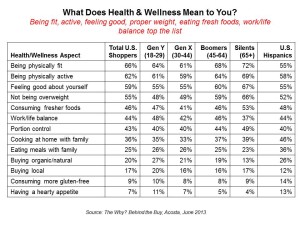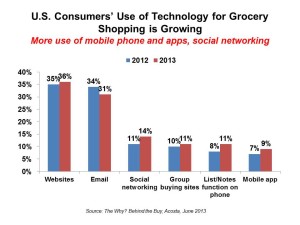 Consumers in America are spending more, and especially at the grocery store. Most people say they want to eat healthy — but, although they’re spending more at the food store, one-half of supermarket shoppers say cost is the main obstacle for healthy eating.
Consumers in America are spending more, and especially at the grocery store. Most people say they want to eat healthy — but, although they’re spending more at the food store, one-half of supermarket shoppers say cost is the main obstacle for healthy eating.
2 in 3 U.S. grocery shoppers define health and wellness as being physically fit and active, and over half believe that feeling good about yourself is another facet of health. Not being overweight equals health for about one-half of U.S. shoppers.
The Why? Behind the Buy, from Acosta Sales & Marketing, explores buying patterns among U.S. consumers in light of the economy turning the corner. The report finds that U.S. shoppers are more confident, spending more money in retail, and looking for healthier food options.
By Spring 2013, fewer Americans are facing less difficulty paying bills, managing credit card debt, and worrying about losing their job.
 Over the past year, consumers have taking on more technology to help them be better grocery shoppers such as social networking, using notes functions on mobile phones, and adopting mobile apps for food and nutrition along with mobile coupons. The second chart shows that mobile and social are up for grocery shopping, and the use of email is down. 7 in 10 shoppers are on Facebook, and about half of them visit brand pages at least once a month looking for coupons and offers (mobile savings is on the rise), supporting causes, and connecting with fellow consumers. That’s Social Shopping, especially among Gen Y and U.S. Hispanics. Acosta found growing use of social shopping beyond Facebook, on Instagram, YouTube, Twitter, Pinterest, Snapchat and other social networks.
Over the past year, consumers have taking on more technology to help them be better grocery shoppers such as social networking, using notes functions on mobile phones, and adopting mobile apps for food and nutrition along with mobile coupons. The second chart shows that mobile and social are up for grocery shopping, and the use of email is down. 7 in 10 shoppers are on Facebook, and about half of them visit brand pages at least once a month looking for coupons and offers (mobile savings is on the rise), supporting causes, and connecting with fellow consumers. That’s Social Shopping, especially among Gen Y and U.S. Hispanics. Acosta found growing use of social shopping beyond Facebook, on Instagram, YouTube, Twitter, Pinterest, Snapchat and other social networks.
Health Populi’s Hot Points: The most important food claims for shoppers are whole grain/wheat, no additives and preservatives, no high fructose corn syrup, lower or no fat, all natural, and cholesterol and health claims.
Consumers are connecting the dots between food and health, and spending money and time to seek out healthier choices. The growth of technology for grocery shopping — from social networks to online tools and mobile apps for lists, meal planning, nutrition and coupons/savings — is bolstering consumer engagement in shopping for health. There is a great opportunity for the health and health care ecosystem – plans, providers, payors, pharmacies, and the food system – to coordinate across silos with the healthier consumer at the center. Health and wellness is top of mind – with savings driving many purchases in the improving economy. The food morphing to health morphing to wealth message is resonating in the U.S. in 2013.




 Thank you, Trey Rawles of @Optum, for including me on
Thank you, Trey Rawles of @Optum, for including me on  I was invited to be a Judge for the upcoming
I was invited to be a Judge for the upcoming  For the past 15 years,
For the past 15 years,